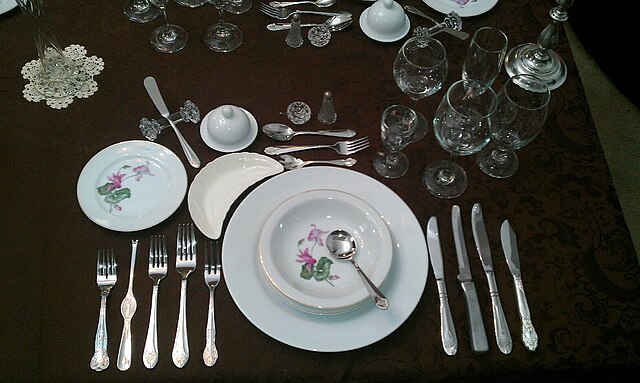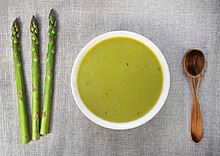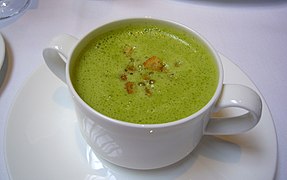Soup
Primarily liquid food From Wikipedia, the free encyclopedia
Soup is a primarily liquid food, generally served warm or hot (but may be cool or cold), that is made by combining ingredients of meat or vegetables with stock, milk, or water. Hot soups are additionally characterized by boiling or simmering solid ingredients in liquids in a pot until the flavors are extracted, forming a broth. Soups are similar to stews, and in some cases there may not be a clear distinction between the two; however, soups generally have more liquid (broth) than stews.[1]
This article has multiple issues. Please help improve it or discuss these issues on the talk page. (Learn how and when to remove these messages)
|
In traditional French cuisine, soups are classified into two main groups: clear soups and thick soups. The established French classifications of clear soups are bouillon and consommé. Thick soups are classified depending upon the type of thickening agent used: purées are vegetable soups thickened with starch; bisques are made from puréed shellfish or vegetables thickened with cream; cream soups may be thickened with béchamel sauce; and veloutés are thickened with eggs, butter, and cream. Other ingredients commonly used to thicken soups and broths include rice, lentils, flour, and grains; many popular soups also include pumpkin, carrots, potatoes, pig's trotters and bird's nests.[2]
Other types of soup include fruit soups, dessert soups, pulse soups such as split pea, cold soups and other styles.
History
Summarize
Perspective

(William-Adolphe Bouguereau, 1865)
The earliest evidence for soup in human culinary practice dates to the Upper Palaeolithic period when thermally altered rocks became commonplace in the archaeological record.[3][4] Small boiling pits are present on the Gravettian site Pavlov VI.[5] Cobbles were heated on the hearth and then placed into the water to bring it to boil. However, the antiquity of soup is highly contested. Based on ethnographic evidence, some archaeologists conjecture that early humans employed hides and watertight baskets to boil water.[6]
The word soup comes from French soupe ("soup", "broth"), which comes through Vulgar Latin suppa ("bread soaked in broth") from a Germanic source, from which also comes the word "sop", a piece of bread used to soak up soup or a thick stew.
The word restaurant (meaning "[something] restoring") was first used in France in the 16th century, to refer to a highly concentrated, inexpensive soup, sold by street vendors, that was advertised as an antidote to physical exhaustion.[7] In 1765, according to Prosper Montagné's Larousse Gastronomique, a Parisian entrepreneur opened a shop specializing in such soups. This prompted the use of the modern word restaurant to refer to eating establishments.[8]
In the US, the first colonial cookbook was published by William Parks in Williamsburg, Virginia, in 1742, based on Eliza Smith's The Compleat Housewife; or Accomplished Gentlewoman's Companion, and it included several recipes for soups and bisques. A 1772 cookbook, The Frugal Housewife, contained an entire chapter on the topic. English cooking dominated early colonial cooking; but as new immigrants arrived from other countries, other national soups gained popularity. In particular, German immigrants living in Pennsylvania were famous for their potato soups. In 1794, Jean Baptiste Gilbert Payplat dis Julien, a refugee from the French Revolution, opened an eating establishment in Boston called "The Restorator", and became known as the "Prince of Soups". The first American cooking pamphlet dedicated to soup recipes was written in 1882 by Emma Ewing: Soups and Soup Making.
Portable soup was devised in the 18th century by boiling seasoned meat until a thick, resinous syrup was left that could be dried and stored for months at a time.[9]
Commercial products
Summarize
Perspective

Commercial soup became popular with the invention of canning in the 19th century, and today a great variety of canned and dried soups are on the market.
Canned
Canned soup can be condensed, in which case it is prepared by adding water (or sometimes milk) or it can be "ready-to-eat", meaning that no additional liquid is needed before eating. Condensed soup (invented in 1897 by John T. Dorrance, a chemist with the Campbell Soup Company[10][11]) allows soup to be packaged into a smaller can and sold at a lower price than other canned soups. The soup is usually doubled in volume by adding a "can full" of water or milk, about 10 US fluid ounces (300 ml). The "ready-to-eat" variant can be prepared by simply heating the contents of the can on a kitchen stove or in a microwave oven, rather than actually cooking anything. Such soups can be used as a base for homemade soups, with the consumer adding anything from a few vegetables to eggs, meat, cream or pasta.
Since the 1990s, the canned soup market has burgeoned, with non-condensed soups marketed as "ready-to-eat", so they require no additional liquid to prepare.[citation needed] Microwaveable bowls have expanded the "ready-to-eat" canned soup market even more, offering convenience (especially in workplaces), and making for popular lunch items. In response to concerns over the negative health effects of excessive salt intake, some soup manufacturers have introduced reduced-salt versions of popular soups.[12]
Today, Campbell's Tomato (introduced in 1897), Cream of Mushroom, and Chicken Noodle (introduced in 1934) are three of the most popular soups in America. Americans consume approximately 2.5 billion bowls of these three soups alone each year.[10] Other popular brands of soup include Progresso.
Dried

Dry soup mixes are sold by many manufacturers, and are reconstituted with hot water; other fresh ingredients may then be added.
The first dried soup was bouillon cubes; the earlier meat extract did not require refrigeration, but was a viscous liquid.
East Asian-style instant noodle soups include ramen and seasonings, and are marketed as a convenient and inexpensive instant meal, requiring only hot water for preparation.[13] While North American ones tend to have a powder pack only, instant noodles sold in East Asia commonly include a pack of dried vegetables too.
Western-style dried soups include vegetable, chicken base, potato, pasta and cheese flavors.
Types
Summarize
Perspective

In French cuisine, soup is often served before other dishes in a meal. In 1970, Richard Olney gave the place of the entrée in a French full menu: "A dinner that begins with a soup and runs through a fish course, an entrée, a sorbet, a roast, salad, cheese and dessert, and that may be accompanied by from three to six wines, presents a special problem of orchestration".[14]
Dessert
- Chè, a Vietnamese cold dessert soup containing sugar and coconut milk, with many different varieties of other ingredients including taro, cassava, adzuki bean, mung bean, jackfruit, and durian.
- Ginataan, Filipino soup made from coconut milk, fruits and tapioca pearls, served hot or cold
- Shiruko, a Japanese azuki bean soup
- Tong sui, a collective term for Chinese sweet soups
- Sawine, a soup made with milk, spices, parched vermicelli, almonds and dried fruits, served during the Muslim festival of Eid ul-Fitr in Trinidad and Tobago
- Chinese dessert soups include douhua and black sesame soup
Fruit
Fruit soups are prepared using fruit as a primary ingredient, and may be served warm or cold depending on the recipe. Many varieties of fruit soups exist, and they may be prepared based upon the availability of seasonal fruit.
Cold

Cold soups are a particular variation on the traditional soup, wherein the temperature when served is kept at or below room temperature. They may be sweet or savory. In summer, sweet cold soups can form part of a dessert tray. An example of a savory chilled soup is gazpacho, a chilled vegetable-based soup originating from Spain.[15] Vichyssoise is a cold purée of potatoes, leeks, and cream.
Asian
A feature of East Asian soups not normally found in Western cuisine is the use of tofu in soups. Many traditional East Asian soups are typically broths, "clear soups", or starch thickened soups.[citation needed] In China, soup is often the only liquid served with meals, taking on the role of food and beverage at once; they also provide contrast with dry dishes in some meals. When soup is served in meals varies across China: in southern China, they are often served at the beginning to promote appetite, while in Sichuan they are served at the end to cool the body after the spicy preceding dishes.[16]
As a figure of speech
Summarize
Perspective
In the English language, the word soup has developed several uses in phrase, such as duck soup, from soup to nuts and in the soup. It is also invoked as a metaphor in the name for various concepts or descriptors:
- Alphabet soup, a large number of acronyms used by an administration; the term has its roots in a common tomato-based soup containing pasta shaped in the letters of the alphabet
- Pea soup fog, a type of very thick fog caused by air pollution, heavily associated with London
- Primordial soup, the organic mixture leading to the development of life
- Soup kitchen, a place that serves prepared food of any kind to the homeless or needy
- Souperism, the practice of bible societies during the Irish Great Famine to feed the hungry in exchange for religious instruction. The expression 'took the soup' is used to refer to those who converted from Catholicism to Protestantism at the behest of these organizations in return for food
- Tag soup, poorly coded HTML
The direct translation for soup in the Filipino language, sabaw, is used as a figure of speech, referring to moments where one is unable to think straight, as if one's brain is empty, much like a bowl of soup devoid of any ingredients. It can also refer to someone who says something that makes no sense, thereby referring to them as sabog.[17]
Gallery
- Chicken phở
- Vegetable beef barley soup
- Chicken pasta soup
- Chunky tomato soup
See also
References
Further reading
Wikiwand - on
Seamless Wikipedia browsing. On steroids.













